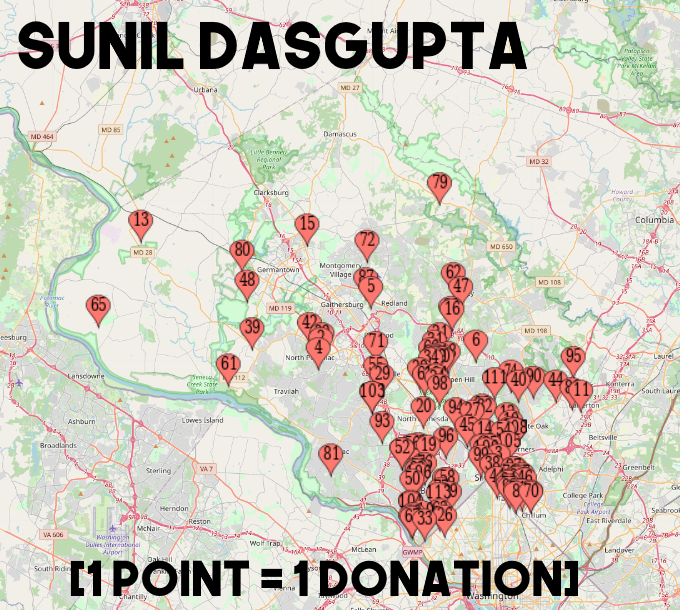MoCo's Wild, Expensive, And Nasty 2020 School Board Primary
- Brian Kramer
- Mar 12, 2021
- 4 min read
Montgomery County had an incredibly contentious school board election in 2020 for one of two At-Large seats on the Board. There were thirteen candidates in an expensive, nasty race that resulted from an ongoing fight over the examination of local school assignment boundaries. It may have been the first instance of the Montgomery County Delegation to Annapolis stepping into the most local of politics: a fight over where kids go to school and why.
Two major factions emerged: those in support of the boundary analysis and of shifting school assignments to diversify schools, and those in opposition to these efforts. In the end, the primary was won fairly decisively by Lynne Harris (the eventual winner of the At-Large school board seat) and Sunil Dasgupta, both of whom supported equity-based boundary changes.
In order to analyze where candidates were receiving their support, I created four maps leading up to the primary. Montgomery County is a very large and diverse county, but can be easily divided into several different regions that would support opposite sides of a proposal such as the controversial boundary analysis. Out-of-county contributions were excluded from this map and multiple donations from the same household were counted as one blip.
Due to precinct data being unavailable for the primary, we can only gather regional support based on the donations received by candidates. It’s important to note that participation in local elections is often done by people who are already very politically engaged and able to understand nuanced local political issues, and that people who donate are often the most civically engaged citizens. While donations are not a perfect metric, I thought they showed a clear regional trend for each of the four candidates I examined: Jay Guan and Stephen Austin had support from regions of the county that were both wealthier and were anxious about current or future redistricting efforts, and Lynne Harris and Sunil Dasgupta had support from the more populated regions of Silver Spring that were far more amicable to potentially shifting school boundaries.

Jay Guan raised the most money overall, which was concentrated in areas that opposed efforts for redistricting including Clarksburg and areas of Rockville zoned for high-performing schools such as Wootton. At the time, I viewed Jay Guan as a formidable candidate for the anti-boundary analysis crowd due to his successful fundraising within these specific communities and his ties to the emerging politically active Asian community in MoCo.

Stephen Austin, the leader of a Facebook group fighting the boundary analysis effort, was the third runner up in total fundraising. However, Stephen Austin’s coalition was far more centered around Bethesda and high-performing Rockville-area schools than around Jay Guan’s primary stomping ground of Clarksburg. Overall, very little of the anti-boundary analysis fundraising came from Silver Spring or other areas in the eastern part of the County, which is voter-rich and diverse.

Sunil Dasgupta, the teacher-union endorsed candidate, also raised a substantial amount of money. Sunil managed to gather donations from every part of the county, including in areas where Jay Guan and Stephen Austin gained a significant amount of traction. However, Sunil’s donations were centered in Silver Spring and the area of Rockville that he lives in, which were amiable to redistricting efforts.

Lynne Harris, the Washington Post endorsed candidate and the eventual winner of the general election in November, received far less fundraising support overall but managed to have the highest concentration of support in one area by far. Most of Lynne’s primary donors were located within a small section of Silver Spring close to where she lives.
Despite wide disparities in candidate fundraising, Lynne Harris rocketed to a first place finish with 29.2% of the vote and Sunil Dasgupta followed in second place at 20.6%. Jay Guan, despite his fundraising haul, placed in 6th out of 13th place with 5.4% of the vote. Stephen Austin finished 3rd with 13% of the vote. Over 210,000 voters participated in the June 2, 2020 primary.
My (brief) analysis of this result and the campaign contributions we’ve seen centered on three questions:
Is raising and spending a lot of money better than receiving a wide variety of local endorsements?
Can candidates win by receiving support from a few areas of MoCo?
Was the boundary analysis as potent as conventional wisdom thought it was?
My answer to these three questions, as shown by the results and these maps, is that local races rely heavily on endorsements rather than solely fundraising, candidates cannot win without diverse geographical support, and the two candidates who advanced from the primary were supportive of the boundary analysis and thus not as controversial as we thought it would be.
While many believed the outrage from the boundary analysis that fueled massive campaign donations and a significant number of candidates running for a single school board seat could result in an electoral victory, these efforts fell very short. Two candidates that supported the boundary analysis and were supported by the two prominent endorsers in MoCo, the Washington Post and the teachers union, ended up cruising to victory. These candidates both happened to be from the less affluent, more populous region of eastern MoCo, showing how regional splits on these sorts of issues usually ends up working out for Silver Spring.
While the 2020 school board primary was the most contentious MoCo had seen in several years because of the boundary analysis, opponents to this measure failed to make it a salient, electorally toxic issue. It remains to be seen if opponents of the boundary analysis will return to the battlefield after the current debates around recovery from COVID-19 subside, but it’s clear they face an uphill battle if they do so.